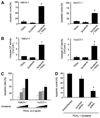Sorafenib inhibits signal transducer and activator of transcription-3 signaling in cholangiocarcinoma cells by activating the phosphatase shatterproof 2
- PMID: 19821497
- PMCID: PMC2891152
- DOI: 10.1002/hep.23214
Sorafenib inhibits signal transducer and activator of transcription-3 signaling in cholangiocarcinoma cells by activating the phosphatase shatterproof 2
Abstract
The Janus kinase/signal transducer and activator of transcription (JAK/STAT) pathway is one of the key signaling cascades in cholangiocarcinoma (CCA) cells, mediating their resistance to apoptosis. Our aim was to ascertain if sorafenib, a multikinase inhibitor, may also inhibit JAK/STAT signaling and, therefore, be efficacious for CCA. Sorafenib treatment of three human CCA cell lines resulted in Tyr(705) phospho-STAT3 dephosphorylation. Similar results were obtained with the Raf-kinase inhibitor ZM336372, suggesting sorafenib promotes Tyr(705) phospho-STAT3 dephosphorylation by inhibiting Raf-kinase activity. Sorafenib treatment enhanced an activating phosphorylation of the phosphatase SHP2. Consistent with this observation, small interfering RNA-mediated knockdown of phosphatase shatterproof 2 (SHP2) inhibited sorafenib-induced Tyr(705) phospho-STAT3 dephosphorylation. Sorafenib treatment also decreased the expression of Mcl-1 messenger RNA and protein, a STAT3 transcriptional target, as well as sensitizing CCA cells to tumor necrosis factor-related apoptosis-inducing ligand (TRAIL)-mediated apoptosis. In an orthotopic, syngeneic CCA model in rats, sorafenib displayed significant tumor suppression resulting in a survival benefit for treated animals. In this in vivo model, sorafenib also decreased tumor Tyr(705) STAT3 phosphorylation and increased tumor cell apoptosis.
Conclusion: Sorafenib accelerates STAT3 dephosphorylation by stimulating phosphatase SHP2 activity, sensitizes CCA cells to TRAIL-mediated apoptosis, and is therapeutic in a syngeneic rat, orthotopic CCA model that mimics human disease.
Conflict of interest statement
Potential conflict of interest: Nothing to report.
Figures







Similar articles
-
Sorafenib inhibits growth and metastasis of hepatocellular carcinoma by blocking STAT3.World J Gastroenterol. 2011 Sep 14;17(34):3922-32. doi: 10.3748/wjg.v17.i34.3922. World J Gastroenterol. 2011. PMID: 22025881 Free PMC article.
-
Potent in vitro and in vivo antitumor activity of sorafenib against human intrahepatic cholangiocarcinoma cells.J Gastroenterol. 2011 Jun;46(6):779-89. doi: 10.1007/s00535-011-0380-3. Epub 2011 Feb 18. J Gastroenterol. 2011. PMID: 21331764
-
Signal transducer and activator of transcription 3 is a major kinase-independent target of sorafenib in hepatocellular carcinoma.J Hepatol. 2011 Nov;55(5):1041-8. doi: 10.1016/j.jhep.2011.01.047. Epub 2011 Feb 24. J Hepatol. 2011. PMID: 21354226
-
Downregulation of signal transducer and activator of transcription 3 by sorafenib: a novel mechanism for hepatocellular carcinoma therapy.World J Gastroenterol. 2014 Nov 7;20(41):15269-74. doi: 10.3748/wjg.v20.i41.15269. World J Gastroenterol. 2014. PMID: 25386075 Free PMC article. Review.
-
STAT3: a target to enhance antitumor immune response.Curr Top Microbiol Immunol. 2011;344:41-59. doi: 10.1007/82_2010_51. Curr Top Microbiol Immunol. 2011. PMID: 20517723 Free PMC article. Review.
Cited by
-
Cyclic AMP/PKA-dependent paradoxical activation of Raf/MEK/ERK signaling in polycystin-2 defective mice treated with sorafenib.Hepatology. 2012 Dec;56(6):2363-74. doi: 10.1002/hep.25872. Epub 2012 Aug 27. Hepatology. 2012. Retraction in: Hepatology. 2023 Sep 1;78(3):E64. doi: 10.1097/HEP.0000000000000485. PMID: 22653837 Free PMC article. Retracted.
-
A Bax-mediated mechanism for obatoclax-induced apoptosis of cholangiocarcinoma cells.Cancer Res. 2010 Mar 1;70(5):1960-9. doi: 10.1158/0008-5472.CAN-09-3535. Epub 2010 Feb 16. Cancer Res. 2010. PMID: 20160031 Free PMC article.
-
MiR-204 silencing in intraepithelial to invasive cutaneous squamous cell carcinoma progression.Mol Cancer. 2016 Jul 25;15(1):53. doi: 10.1186/s12943-016-0537-z. Mol Cancer. 2016. PMID: 27457246 Free PMC article.
-
EF24 inhibits tumor growth and metastasis via suppressing NF-kappaB dependent pathways in human cholangiocarcinoma.Sci Rep. 2016 Aug 30;6:32167. doi: 10.1038/srep32167. Sci Rep. 2016. PMID: 27571770 Free PMC article.
-
Mechanistic Insights about Sorafenib-, Valproic Acid- and Metformin-Induced Cell Death in Hepatocellular Carcinoma.Int J Mol Sci. 2024 Feb 1;25(3):1760. doi: 10.3390/ijms25031760. Int J Mol Sci. 2024. PMID: 38339037 Free PMC article. Review.
References
-
- Bollrath J, Phesse TJ, von Burstin VA, Putoczki T, Bennecke M, Bateman T, et al. gp130-mediated Stat3 activation in enterocytes regulates cell survival and cell-cycle progression during colitis-associated tumorigenesis. Cancer Cell. 2009;15:91–102. - PubMed
-
- Yu H, Jove R. The STATs of cancer–new molecular targets come of age. Nat Rev Cancer. 2004;4:97–105. - PubMed
-
- Aggarwal BB, Sethi G, Ahn KS, Sandur SK, Pandey MK, Kunnumakkara AB, et al. Targeting signal-transducer-and-activator-of-transcription-3 for prevention and therapy of cancer: modern target but ancient solution. Ann N Y Acad Sci. 2006;1091:151–169. - PubMed
Publication types
MeSH terms
Substances
Grants and funding
LinkOut - more resources
Full Text Sources
Medical
Molecular Biology Databases
Research Materials
Miscellaneous
